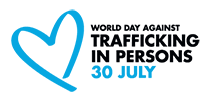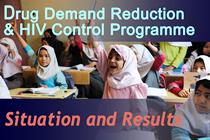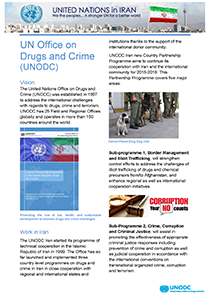Three quarters of the world has limited or no access to
pain relief medications, says INCB Report
INCB Annual Report 2014:
• calls for ensuring access to essential medicines, including in emergency and conflict situations;
• draws attention to the continued threat posed by new psychoactive substances and
• growing use of methylphenidate;
• alerts about deviations from the international drug control conventions; and
• calls for a balanced approach to drug control, greater demand reduction efforts, respect for human rights, and renews appeal for abolishing the death penalty for drug-related offences.
VIENNA, 3 March (UN Information Service) - Around 5.5 billion people still have limited or no access to medicines containing narcotic drugs such as codeine or morphine, leaving 75 per cent of the world population without access to proper pain relief treatment, the Vienna-based International Narcotics Control Board (INCB) says in its Annual Report for 2014, launched today in London.
Underlining this discrepancy, the Report notes that around 92 per cent of morphine used worldwide is consumed by only 17 per cent of the world population, primarily living in the United States, Canada, Western Europe, Australia and New Zealand.
Addressing the discrepancy in the availability of narcotic drugs and psychotropic substances for medical and scientific purposes is one of the obligations for Governments to comply with the International Drug Control Conventions.
To achieve a balanced and integrated approach to the drug problem, Governments also should ensure that demand reduction is one of the first priorities of their drug control policies, while they should put greater emphasis on and provide support and appropriate resources to prevention, treatment and rehabilitation, the Report says.
In its Report, INCB notes drug control measures do not exist in a vacuum and that, in their implementation of the drug control conventions, States must also comply with their obligations under other treaties, including international human rights obligations. While it is up to States to decide on specific sanctions for drug-related offences, INCB calls for the abolition of the death penalty in such cases.
Availability of narcotic drugs in emergency and conflict situations
As the Report points out, natural disasters and armed conflicts around the world can further limit access to essential medicines. The Board therefore reminds States that in cases of emergency medical care, simplified control measures can be applied. This was the case in 2013 in the Philippines following the destruction by Typhoon Haiyan, when the Board pointed out to all countries as well as to providers of humanitarian assistance the simplified procedures for the export, transportation and delivery of medicines containing substances under international control.
States should also be aware, the Report says, that under international humanitarian law parties to armed conflicts have to allow access to medical care, including access to essential medicine, for the civilian population in territories under their control.
New psychoactive substances: a continuing threat
There has been an increase of 11 per cent in the number of new psychoactive substances (NPS) with 388 unique substances identified as of 2014, compared to 348 the previous year. The extent of use of NPS worldwide illustrates the dynamic nature of the drug problem.
Increasing use of methylphenidate
The Report also notes an increase of around 66 per cent in the global consumption of methylphenidate, a stimulant primarily used in the treatment of Attention Deficit Hyperactivity Disorder (ADHD). This may be attributable to various factors including: the increasing number of ADHD patients; a widening of the age group of the population likely to receive the treatment and lack of adequate prescription guidelines added to strong and influential marketing practices. In the United States alone about 11 per cent of young people between the ages of 4 and 17 years had been diagnosed with ADHD. In Germany, the number of ADHD diagnoses increased by 42 per cent in children and adolescents under the age of 19 between 2006 and 2011. The Report also notes that such medicines are abused by a growing number of teenagers and young adults.
Cannabis legislation in Uruguay and some States of the US
Uruguay has become the first state to legalize the production, distribution, sale and consumption of cannabis and its derivatives for recreational purposes. In the United States, the States of Colorado and Washington began the commercial sale and distribution of cannabis for non-medical purposes, and voters in Oregon and Alaska approved a ballot initiative to legalize the commercialization of cannabis for non-medical purposes.
Both the law in Uruguay and the jurisdictions in some States of the US are inconsistent with article 4 of the 1961 Single Convention on narcotic drugs, which requires States to limit the use of narcotic drugs to medical and scientific purposes.
REGIONAL TRENDS
Persistent threats to peace and security in parts of Africa have spurred an increase in illicit drug trafficking. Eastern Africa has increasingly become a transit route for heroin bound for markets in South Africa and West Africa. Southern Africa continues to be a hub for the global transit of heroin and cocaine. The prevalence of abuse of cannabis remains a major concern for the continent.
Central America and the Caribbean continue to be exploited by local and international organized criminal groups as a trans-shipment route for illicit drugs originating in South America and destined for North America and Europe. Cocaine trafficking remains the most lucrative source of income for organized criminal groups and there is also a growing trend towards increased production of illicit drugs.
The highest drug-related mortality rate of any region in the world is in North America. In the United States, there are more drug overdose deaths, primarily related to prescription opioids, than homicides and road accident fatalities. Especially in the US there is a growing trend of heroin abuse after years of decline. Cannabis, however, continues to be the most widely available, abused and trafficked drug in North America, with worrying use by youth. Illicit cannabis production and trafficking has continued to increase, while the potency of cannabis in the region has risen sharply too. In Canada, government studies show that cannabis is widely abused by youth, aged 11-18 years with 1 in 5 having used cannabis in the last 12 months.
In South America, the total area under cultivation for coca bush in Bolivia, Colombia, and Peru fell by approximately one third between 2007 and 2013. A special concern in the region is the consumption of smokeable forms of cocaine, and there is also increased cannabis use in Chile and Colombia. Colombia and Paraguay emerge as the most prominent source countries for cannabis herb trafficked across borders in South America.
The expansion of illicit markets for amphetamine-type stimulants remains the biggest concern in East and South-East Asia. In South Asia, the rise in manufacturing, trafficking and abuse of methamphetamine, as well the diversion and abuse of pharmaceutical preparations containing narcotic drugs and psychotropic substances remain among the greatest drug-related challenges.
In West Asia, sustained growth in opiate abuse and illicit opium cultivation in Afghanistan pose major challenges to the region as well. Opium poppy cultivation increased 7 per cent, while opium production in the country has increased by 17 per cent over the previous year. There is also an increase in the trafficking of Afghan heroin through Sri Lanka. Average seizures have increased tenfold, from 35 kilograms in 2012 to 350 kilograms in 2013.
In Europe, the availability and abuse of new psychoactive substances remain a major public health challenge, with a record number of such substances being newly identified. Eastern and South¬Eastern Europe register significantly higher prevalence rates than the global average both for people who inject drugs and for people who inject drugs and are also living with HIV. Deaths associated with heroin abuse are declining, while deaths linked to synthetic opioids are on the rise. Seizures of heroin along the Balkan route increased, and heroin continued to be redistributed in the Netherlands and, to a lesser extent, in Belgium for illicit markets in Western Europe.
Illicit cultivation of cannabis in Western and Central Europe, primarily for domestic consumption, continues to spread, but cannabis also continues to be trafficked into this region, including through the transport of cannabis resin mainly from Morocco, and the trafficking of cannabis herb, mainly from Albania.
The expanding markets for new psychoactive substances and comparatively high rates of drug abuse in Australia and New Zealand are a matter of concern. Cannabis remains the most abused drug and is predominantly locally produced.
Precursors report
In its Precursors Report the Board highlights the need to make precursors control fit for the future. INCB has been advocating fine-tuning the control system, placing more emphasis on voluntary measures and cooperation with a range of industries at all levels. The Board also notes a trend of traffickers increasingly seeking purpose-made chemicals that are not available off-the-shelf.
***
More information is available at http://www.unis.unvienna.org/unis/en/events/2015/incb_2015.html



